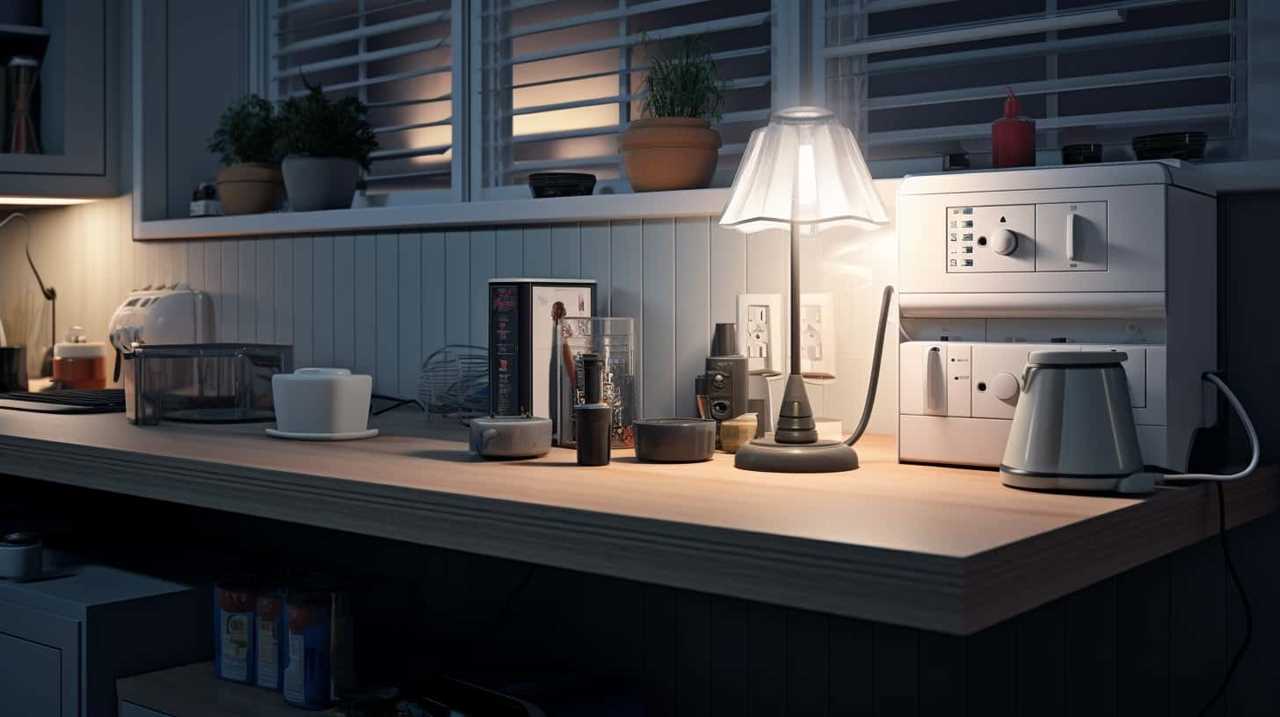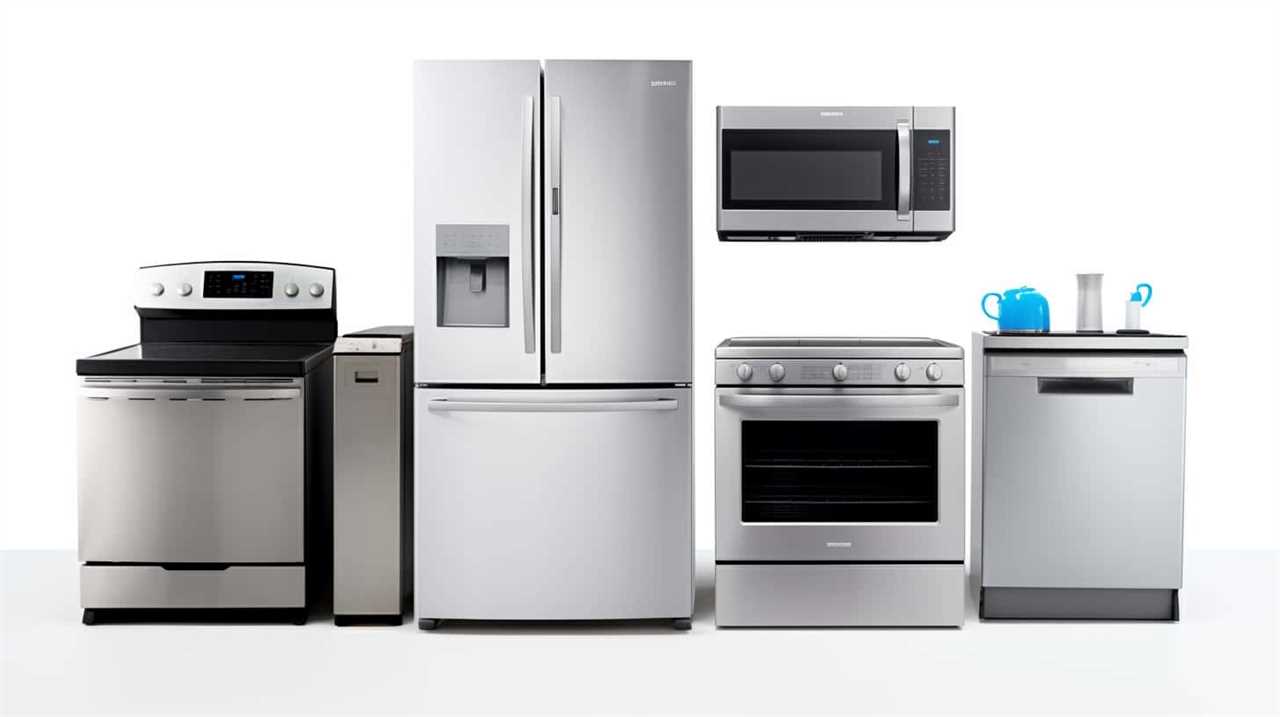Did you know that some appliances are eligible for energy credits on your taxes? It is important to understand the eligibility criteria and energy efficiency requirements to determine which appliances qualify.
In this article, we will explore the types of appliances that are eligible, the Energy Star certification requirements, and the common misconceptions surrounding energy credits.
Additionally, we will discuss other tax incentives for energy efficiency and provide resources for further information.
Let’s dive into the world of energy credits and maximize our tax savings.

Key Takeaways
- Eligible appliances must meet specific energy efficiency requirements, including Energy Star certification.
- The maximum credit amount for eligible improvements is $500, with specific credit limits for different types of improvements.
- Keeping detailed records of purchase dates, costs, and receipts is essential for claiming energy credits.
- Additional tax incentives for energy efficiency are available at the state, local, and federal levels, depending on location and the specific measures implemented.
Energy Credit Eligibility Criteria
The eligibility criteria for the energy credit are specified by the Internal Revenue Service and determine whether individuals can claim the credit on their taxes. Understanding these eligibility requirements is crucial when it comes to claiming energy credits.
To be eligible for the credit, taxpayers must meet certain criteria, such as installing qualified energy-efficient improvements in their homes. These improvements can include things like solar panels, wind turbines, geothermal heat pumps, and energy-efficient windows and doors.
Additionally, there are specific requirements regarding the usage of renewable energy sources. For example, solar panels must be used to generate electricity for the taxpayer’s primary residence.
It’s important to carefully review the eligibility criteria outlined by the IRS to ensure that you meet all the necessary requirements in order to claim the energy credit on your taxes.

Understanding Appliance Energy Efficiency
When it comes to understanding appliance energy efficiency, we can explore how certain appliances can contribute to meeting the eligibility criteria for claiming energy credits on our taxes.
Energy efficient appliances are designed to consume less energy while still providing the same level of functionality. These appliances are equipped with advanced features and technologies that maximize energy savings.
By using energy efficient appliances, we can significantly reduce our energy consumption and lower our utility bills. Additionally, energy efficient appliances have a positive impact on the environment by reducing greenhouse gas emissions.
To further enhance energy savings, there are a few energy saving tips we can follow, such as using appliances during off-peak hours and properly maintaining them.

Understanding the benefits of energy efficient appliances is crucial for making informed purchasing decisions and ultimately qualifying for energy credits on our taxes.
In the next section, we’ll discuss the types of appliances that qualify for these credits.
Types of Appliances That Qualify
When it comes to appliances that qualify for energy credits on taxes, it’s important to understand the eligible appliance categories and the energy efficiency requirements.
Certain types of appliances, such as refrigerators, dishwashers, and washing machines, may be eligible for the credit if they meet specific energy efficiency standards set by the government.

Eligible Appliance Categories
We can identify several eligible appliance categories that qualify for the energy credit on our taxes. To determine if an appliance is eligible for the energy credit, it must meet certain energy credit eligibility criteria.
The categories of appliances that typically qualify for the energy credit include heating and cooling systems, water heaters, biomass stoves, and energy-efficient windows and doors. These appliances are required to meet specific energy efficiency requirements, which we’ll discuss in the next section.
It’s important to note that not all models within these categories may qualify for the credit, so it’s crucial to carefully review the eligibility criteria and consult with a tax professional if needed. Understanding the eligible appliance categories is the first step towards maximizing the energy credit on our taxes.
Moving forward, let’s delve into the energy efficiency requirements that these appliances must meet.

Energy Efficiency Requirements
To qualify for the energy credit on our taxes, eligible appliances must meet specific energy efficiency requirements. These requirements are based on energy savings benefits and are determined by energy efficiency ratings.
The energy efficiency rating is a measurement of how efficiently an appliance uses energy. Appliances with higher energy efficiency ratings consume less energy and therefore provide greater energy savings benefits.
The specific energy efficiency requirements vary depending on the type of appliance. For example, refrigerators must meet the ENERGY STAR® requirements to qualify for the energy credit. Similarly, heating and cooling systems must meet certain Seasonal Energy Efficiency Ratio (SEER) and Energy Efficiency Ratio (EER) requirements.
It’s important to carefully review the energy efficiency ratings and requirements of each eligible appliance to ensure they meet the necessary criteria for the energy credit.

Energy Star Certification Requirements
Appliances must meet Energy Star certification requirements to qualify for the energy credit on our taxes. The Energy Star certification process ensures that appliances meet strict energy efficiency standards set by the Environmental Protection Agency (EPA). Here are some key points about Energy Star certification:
- The process involves rigorous testing and verification to ensure that appliances meet energy efficiency criteria.
- Energy Star appliances are designed to consume less energy, resulting in reduced energy bills and environmental impact.
- These appliances use advanced technologies and innovative features to deliver superior performance while consuming less energy.
By choosing Energy Star appliances, we can enjoy the following benefits:
- Lower energy bills: Energy Star appliances can significantly reduce our energy consumption, leading to lower utility bills.
- Environmental protection: These appliances help conserve energy and reduce greenhouse gas emissions, contributing to a healthier planet.
- Quality and reliability: Energy Star appliances undergo stringent testing to ensure high performance and durability.
Understanding the Energy Star certification process and the benefits of Energy Star appliances helps us make informed decisions about our purchases and ultimately reduce our energy consumption.
Now, let’s explore energy credit limits and percentages.

Energy Credit Limits and Percentages
Now let’s delve into the energy credit limits and percentages that apply to Energy Star certified appliances on our taxes.
When it comes to claiming energy credits for these appliances, it’s important to understand the limits and percentages involved. The energy credit application process requires you to fill out Form 5695 and submit it with your tax return.
The maximum credit amount for eligible energy-efficient improvements is $500. However, each individual type of improvement has its own credit limit. For example, windows and doors have a credit limit of $200, while certain types of heating and cooling systems have a credit limit of $300.
It’s also worth noting that the energy credit expiration dates vary depending on the type of improvement. Therefore, it’s crucial to keep track of these dates to ensure you can claim the credit within the required timeframe.

How to Claim Energy Credits on Taxes
When claiming energy credits on our taxes, we can easily do so by following a few simple steps. Here’s how to claim energy credits and calculate tax deductions:
- Determine eligibility: Identify which energy-efficient improvements and appliances qualify for energy credits. Refer to the IRS guidelines or consult a tax professional for a comprehensive list.
- Gather necessary documentation: Collect receipts, invoices, and other relevant documents that prove the purchase and installation of eligible energy-efficient items.
- Complete Form 5695: Use this form to calculate the amount of energy credits you’re eligible for and to claim them on your tax return.
By following these steps, we can accurately claim energy credits on our taxes and maximize our potential deductions.
Now, let’s move on to the next section and discuss the importance of record-keeping for appliance purchases.
Record Keeping for Appliance Purchases
After determining eligibility for energy credits, it’s important for us to establish a system for record-keeping when it comes to our appliance purchases. Implementing a robust record-keeping system brings several benefits, such as ensuring accurate documentation and facilitating the tracking of expenses.

By maintaining detailed records of appliance purchases, we can easily access information needed for tax purposes and potential audits. Additionally, tracking expenses allows us to monitor our spending and budget effectively.
When it comes to record-keeping, it’s crucial to document the purchase date, cost, and any relevant receipts or invoices. Organizing this information in a centralized location, such as a dedicated folder or digital file, can streamline the process and minimize the risk of misplacing important documentation.
Tips for Maximizing Energy Credits
To maximize our energy credits, we can take advantage of a few helpful tips that build upon our previous discussion on record-keeping for appliance purchases. By implementing these strategies, we can ensure that we’re maximizing our tax deductions and taking full advantage of energy-saving home improvements.
- Conduct a home energy audit: Hiring a professional to assess our home’s energy efficiency can help identify areas where improvements can be made, such as insulation, windows, or HVAC systems.
- Research eligible upgrades: Familiarize ourselves with the energy-efficient products and improvements that qualify for tax credits, such as solar panels, geothermal systems, or energy-efficient windows.
- Keep detailed documentation: Maintain accurate records of all energy-saving home improvements, including receipts, invoices, and product information, as proof of eligibility for tax credits.
Common Misconceptions About Energy Credits
There are several common misconceptions about energy credits that need to be addressed.

First, it’s important to understand the eligible appliance categories that qualify for the credit, which include items such as solar panels, wind turbines, and geothermal heat pumps.
Second, it’s crucial to be aware of the maximum credit amount that can be claimed for each category, as this can vary depending on the specific appliance.
Lastly, individuals should be prepared to provide proof of energy efficiency when claiming the credit to ensure eligibility and avoid any potential misunderstandings.
Eligible Appliance Categories
In our experience, many people have misconceptions about the eligible appliance categories for energy credits on taxes. To help you gain a better understanding of appliance standards and energy credit qualifications, we’ve compiled a list of the most frequently asked questions:

- Are all appliances eligible for energy credits?
- No, only specific categories of appliances qualify, such as refrigerators, dishwashers, and washing machines.
- Do energy-efficient light bulbs count?
- Unfortunately, no. While energy-efficient lighting is important, it doesn’t fall under the eligible appliance categories for tax credits.
- Can I claim credits for both residential and commercial appliances?
- Yes, as long as they meet the requirements, both residential and commercial appliances can qualify for energy credits on your taxes.
Now that we’ve clarified the eligible appliance categories, let’s move on to the next section about the maximum credit amount.
Maximum Credit Amount
Now, let’s delve into some common misconceptions about energy credits, specifically the maximum credit amount that can be claimed. Many taxpayers mistakenly believe that there is no limit to the credit amount they can receive for energy-efficient appliances. However, it is important to understand that there are specific limits set by the government. The maximum credit amount varies depending on the type of appliance and its energy efficiency criteria. To provide a clearer picture, here is a table outlining the maximum credit amounts for different appliance categories:
| Appliance Category | Maximum Credit Amount |
|---|---|
| Refrigerators | $300 |
| Heat Pumps | $300 |
| Central AC | $300 |
| Water Heaters | $300 |
| Furnaces | $150 |
It is crucial to meet the energy credit eligibility criteria and understand the specific maximum credit amounts applicable to each appliance category. Understanding these limits can help taxpayers make informed decisions when claiming energy credits on their taxes. Now, let’s move on to the next section, where we will discuss the proof of energy efficiency required for claiming these credits.
Proof of Energy Efficiency
To claim energy credits on taxes, we must provide proof of energy efficiency for the appliances. This proof is essential to ensure that the claimed credits are valid and backed by evidence. Here are three important points regarding proof of energy efficiency:

- Documentation: To validate energy savings, it’s necessary to keep all relevant documentation, such as receipts, invoices, and ENERGY STAR labels. These documents serve as evidence of the energy-efficient appliance purchase and its associated energy savings.
- Energy Savings Calculation: Along with the documentation, it’s crucial to calculate the energy savings accurately. This calculation involves comparing the energy consumption of the new appliance with that of a standard, less efficient model. The difference in energy consumption represents the energy savings.
- Certification: Energy-efficient appliances must be certified by reputable organizations, such as the U.S. Environmental Protection Agency (EPA) or the Department of Energy (DOE). This certification further validates the appliance’s energy efficiency and provides assurance to the taxpayer.
Other Tax Incentives for Energy Efficiency
We can also take advantage of additional tax incentives for energy efficiency. In addition to the energy-saving home improvements that qualify for the energy credit, there are other rebates and incentives available to help us save on our taxes.
These incentives vary depending on our location and the specific energy-efficient measures we’ve implemented in our homes. Some examples of these incentives include state and local rebates for installing energy-efficient appliances, solar panels, or insulation. There are also federal tax credits available for residential renewable energy systems, such as solar water heaters or geothermal heat pumps.
By taking advantage of these additional tax incentives, we can further reduce our energy costs and contribute to a more sustainable future.
Now, let’s explore some resources for more information on energy credit.

Resources for Energy Credit Information
In our search for information on energy credit, we can explore various resources that provide guidance and assistance. Here are some helpful resources to navigate the energy credit application process and understand the benefits of energy credits:
- IRS Website: The Internal Revenue Service (IRS) website is a reliable source for up-to-date information on energy credits. It provides detailed instructions, forms, and publications to help you understand the eligibility criteria and how to claim the credit.
- EnergyStar: The EnergyStar program, administered by the U.S. Environmental Protection Agency (EPA), offers valuable information on energy-efficient products and tax credits. Their website provides a list of eligible products and guidance on how to calculate the credit.
- Tax Professionals: Consulting with a tax professional who specializes in energy credits can provide personalized advice and ensure compliance with tax regulations.
Consult a Tax Professional for Expert Advice
When it comes to determining whether appliances qualify for energy credits on taxes, it’s important to consult a tax professional for expert advice.
These professionals have in-depth knowledge of the tax laws and regulations, and can provide guidance on the eligibility of appliances for energy credits.
They can also help navigate through the complex requirements and documentation needed to claim the credits accurately.

Tax Professional Recommendations
Although consulting a tax professional is recommended for expert advice, it’s important to understand the qualifications for energy credits on appliances. When it comes to tax filing and energy savings, here are some recommendations from tax professionals:
- Research: Conduct thorough research on energy-efficient appliances and their eligibility for tax credits. Look for reliable sources such as the IRS website or consult a tax professional for accurate information.
- Documentation: Keep all receipts, product specifications, and certification documents to prove that the appliances meet the required energy efficiency standards.
- Consultation: Seek guidance from a tax professional who specializes in energy credits. They can provide personalized advice based on your specific situation and help you navigate the complex tax laws.
Energy Credit Eligibility
To determine the eligibility for energy credits on appliances, it is essential to consult a tax professional for expert advice. They can guide you through the energy credit application process and help you understand the energy credit documentation requirements. Applying for energy credits requires careful attention to detail and accurate documentation. A tax professional can ensure that you meet all the necessary requirements and provide the necessary documentation to claim the energy credits. They can also advise you on the specific appliances that qualify for energy credits and help you maximize your potential tax savings. By seeking the expertise of a tax professional, you can navigate the complex energy credit eligibility process with confidence and ensure that you take full advantage of available tax incentives.
| Application Process | Documentation Requirements |
|---|---|
| Complete application form | Proof of purchase for qualifying appliances |
| Provide necessary documentation | Manufacturer’s certification statement |
| Submit application to relevant tax authorities | Energy Star certification, if applicable |
| Keep copies of all documentation for your records | Receipts and invoices for appliance purchases |
Frequently Asked Questions
Can I Claim Energy Credits on My Taxes if I Purchased Used Appliances?
We can claim energy credits on our taxes for new appliances and energy efficient upgrades. However, it is unclear if used appliances qualify for these credits. Further research or consulting a tax professional is recommended.
Are There Any Income Limitations to Qualify for Energy Credits?
There may be income limitations to qualify for energy credits. Eligibility criteria often include specific income thresholds. To determine if you meet these requirements, consult the guidelines provided by the IRS or a tax professional.

Do Energy Credits Apply to Appliances That Were Purchased Before a Certain Year?
Energy credits for appliances can provide tax benefits for energy-efficient models. It’s important to determine whether these credits apply to appliances purchased before a certain year to ensure eligibility for potential tax savings.
Can I Claim Energy Credits for Appliances That I Use for Business Purposes?
Yes, we can claim energy credits for personal appliances used for business purposes. However, it’s important to note that appliances used for rental properties may also qualify for energy credits on taxes.
Are There Any Specific Requirements for the Installation of Energy-Efficient Appliances to Qualify for Energy Credits?
There are specific requirements for the installation of energy-efficient appliances to qualify for energy credits. Meeting these installation qualifications is crucial to ensure eligibility for the tax benefits associated with energy-efficient appliances.
Can I Claim Energy Credits on Taxes for Appliances as a Capital Expense?
Yes, you can claim energy credits on taxes for capital expenses for appliances. These credits are available for certain energy-efficient home improvements, including the installation of energy-efficient appliances. Make sure to check the eligibility requirements and the specific credit amounts for each appliance before claiming them on your taxes.
Conclusion
In conclusion, understanding the eligibility criteria and requirements for energy credits on appliances is crucial for maximizing tax benefits. By investing in energy-efficient appliances that meet the Energy Star certification requirements, individuals can qualify for tax incentives.

While there may be common misconceptions about energy credits, it’s important to consult a tax professional for expert advice and to explore other tax incentives for energy efficiency.
Remember, knowledge is power when it comes to saving money and conserving energy.









